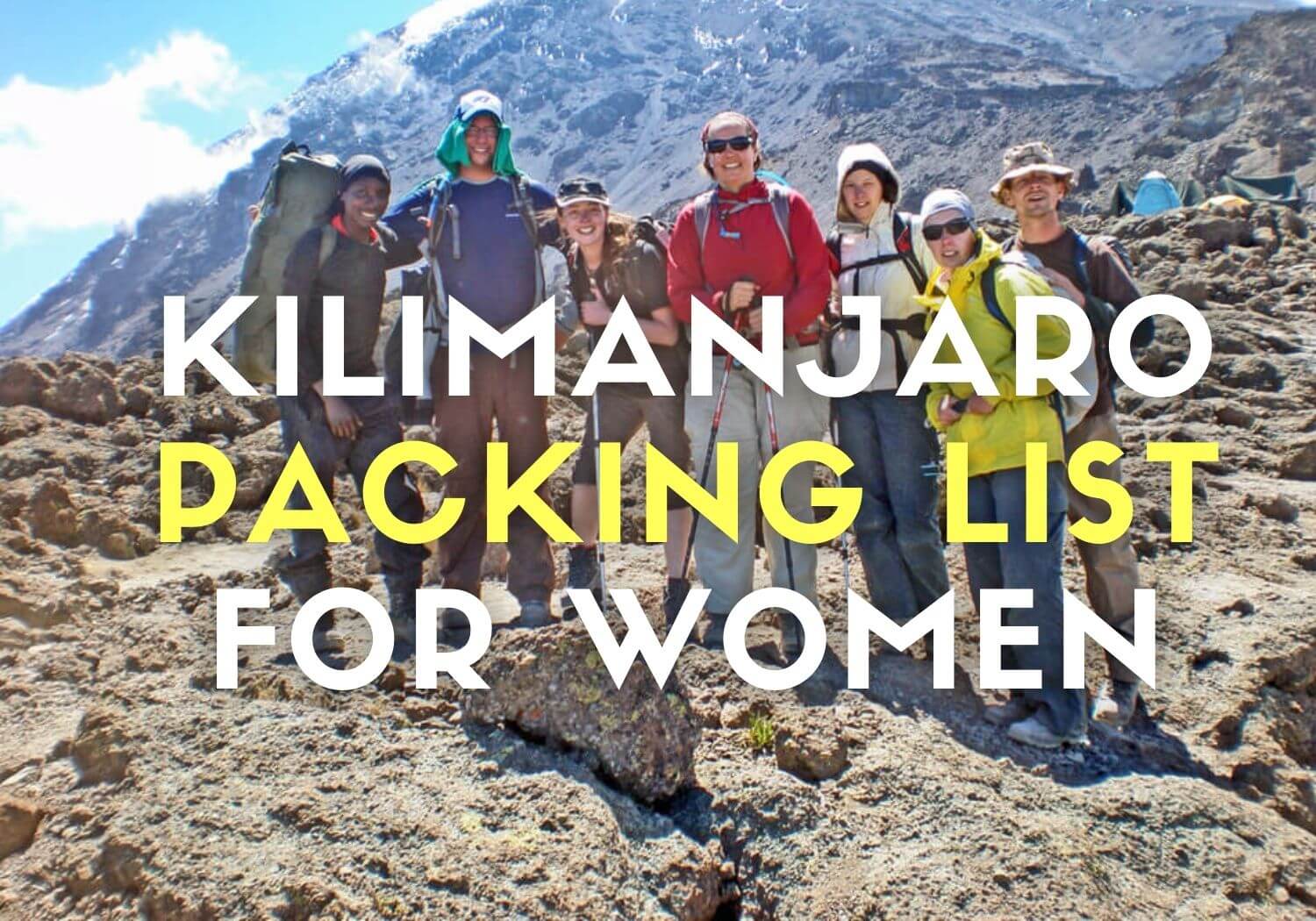Wondering what to pack for our Kilimanjaro trek? In this article you will find a handy gear packing list for hiking Kilimanjaro.
Generally speaking, packing for Kilimanjaro requires versatile clothing that is comfortable and accounts for the dramatic change in temperatures during the ascent. While you will start at around 2,000m above sea level at a comfortable altitude and temperature, at the peak, the temperatures will drop below freezing so it’s important to be prepared.
See our Amazon Kilimanjaro packing list with all the product recommendations mentioned here.
Note: This is only a list of recommendations to use as a guideline and we have added rationale for why some items are useful so you can decide if you should bring them or not. If you can, we highly recommend training in similar conditions to that of Kili (high altitude and cold) so you know what gear you use and which you won’t. And remember that you can hire any gear in Tanzania to cut down on the costs of extra luggage.
Tanzania banned plastic bags in 2019. That means that it is forbidden to bring any plastic bags in, including those you may use to go through airports and put your toiletries in, so leave them at home and don’t pack any for Kilimanjaro.
The weather during a Kilimanjaro trek
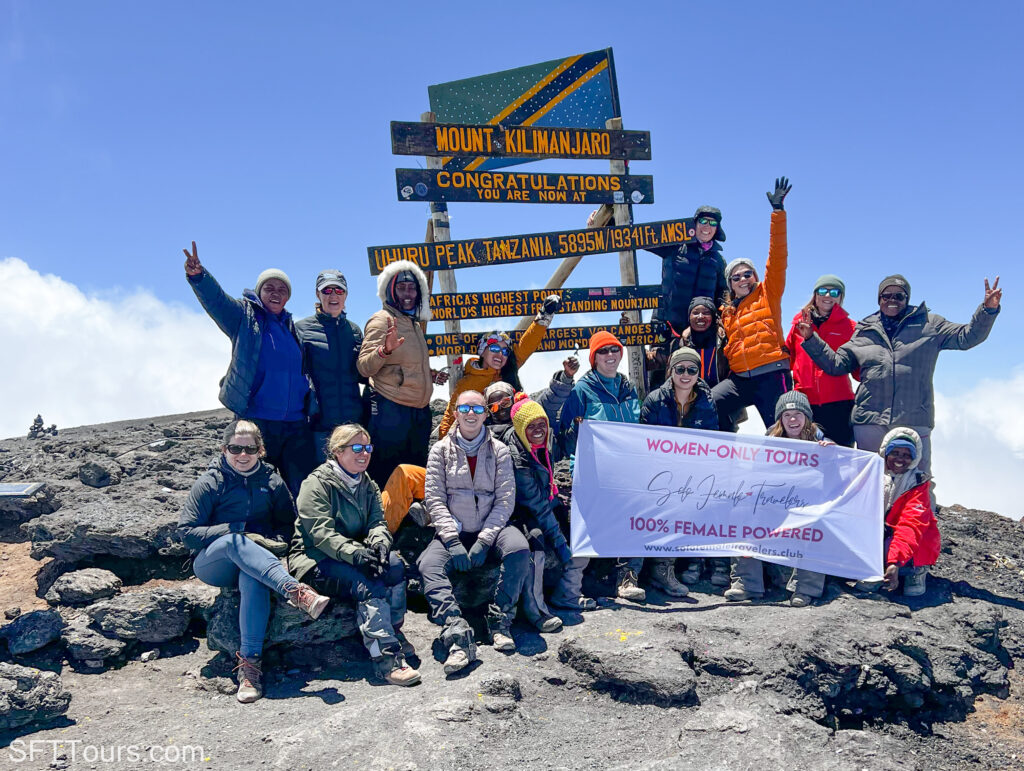
A Kilimanjaro trek will take you from about 1,600m to 2,000m (5,250 to 6,560 feet) above sea level in Arusha, to the top of Africa which towers close to 6,000m (19,685 feet) above sea level.
During the journey you will hike through grasslands, rocky areas, dry alpine deserts and glaciers.
These changes in landscape and eco-system make the trek beautiful, but also require you to consider the impact they may have on your body. The weather can go from sunny to snow or rain, sometimes all in a day’s trek.
Besides the weather, you should also consider the conditions. You will start hiking through rainforest and will spend most of the trek among alpine desert conditions where the weather is very dry.
This could cause cold sores, skin dryness and nose bleeds, so we recommend being prepared with a first-aid kit for weather related conditions.
Temperatures will also vary a lot. For most of the trek (above 3,000m / 9,843 feet), they will range between 15 C (59 F) during the day to -10 C (14 F) at night and can drop to -20 C (-4 F) on summit day, made worse by the wind.
This is why it’s important to pack in layers with all-weather clothing that can take you from day to night and from sun to rain to wind to freezing. Versatile and multi-use pieces are best.
A typical day on Kilimanjaro
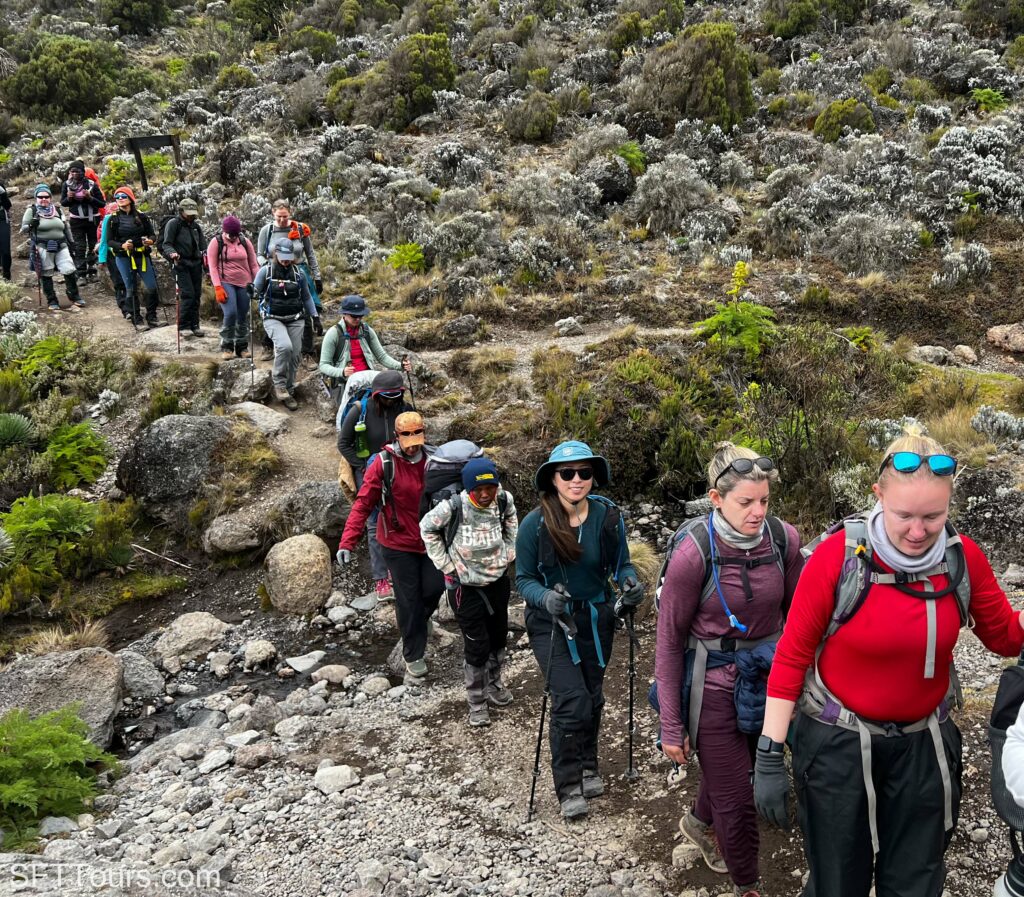
Most days on Kilimanjaro will start and finish early as we will follow the hours of sunlight.
Our itinerary indicates how many hours we will trek every day and the rest of the time will be spent at camp, resting, eating, talking to other guests and admiring the views.
While hiking requires sturdy clothing and footwear, we recommend wearing comfortable clothes at camp, especially loose footwear that will let your feet relax. You may use the same clothing you’ll wear at camp to sleep in and change from the hiking clothes as soon as you arrive.
Packing tips for your Kilimanjaro trek
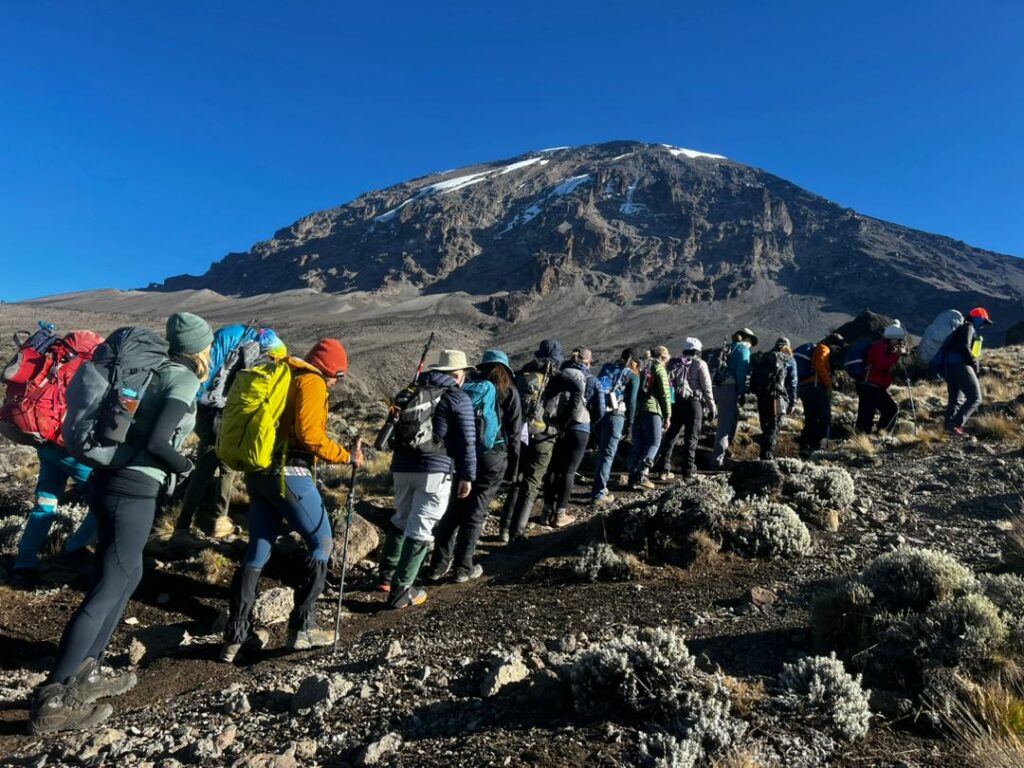
Before we dive into our Kilimanjaro packing list in detail and look at everything we recommend bringing, we want to provide some general packing tips to bear in mind.
Note: Click here to see all our item recommendations in one place on our Amazon Storefront.
Pack in soft luggage
We can’t stress this enough. Porters will carry your bags so it is important that they can easily grab them and place them over their heads or carry them on their backs as backpacks.
Brands like Osprey or Cotopaxi have great backpack options for you to choose from. Hard shell cases and wheeled bags add extra weight and make the porter’s work really hard, so please leave them at home.
Pack light
The baggage allowance on the mountain is no more than 15kg, this is strictly regulated to ensure the proper care and welfare of the porters and includes all of your gear.
All bags will be officially weighed at the park’s entry gate so the weight limitation is recorded per guest entering the mountain. If you have extra gear that you will not need for the climb (eg. safari or beach clothing), you will be able to store it in Arusha.
Bring locks for both the bag you may leave behind and the duffel bag you’ll take with you. You can also grab an electronic hand luggage scale which you clip onto the handle of your bag and simply pull upward to reveal the weight to make sure your bags are never overweight again!
Layer up
The best way to pack for the climb is by wearing a few layers of comfortable clothing that can take you from warm temperatures to freezing weather with strong winds (which you will no doubt encounter towards the top and at night). If the temperatures drop, you can put layers on, and if they increase you can peel them off.
You can carry all your necessary layers in your day pack which will be with you during the day, as you hike from camp to camp.
There is no *real* dress code on Kilimanjaro
Worry less about looking good on Kilimanjaro than about being comfortable, protected and warm.
Remember that showers are not really available on the mountain and that everyone will look scruffy, tired and in need of a wash, so looking good should be the least of your worries.
Instead of packing new boots, bring your most worn out ones so you make sure they are broken in and will not give you blisters.
Cover up
We recommend wearing long sleeves and long trousers to protect from the sun which is very strong at higher altitudes. And don’t forget your sunscreen and a hardcore lip balm.
This one is moisturising and mineral which means it offers a physical barrier, which is what you need at higher altitudes. Just because it’s cold it doesn’t mean you won’t get sunburnt (remember that ski trip where you got the worst nose sunburnt ever?).
Water and wind proof
Windproof, quick dry and waterproof gear is recommended from head to toe including your backpack. Rain at lower altitudes or snow at higher ones, can happen anytime and there won’t be any cover or shelter on the mountain.
Be sustainable and environmentally conscious
We will be camping in wild camps with limited to no facilities. There is no waste management or sewage, that means we need to take all our rubbish with us and leave nothing behind.
If you carry any single use plastic item, make sure to take the packaging back with you and if you bring snacks, pack away the wrappers. Kilimanjaro National Park is a fragile eco-system that needs our protection.
Seal things off
Dust can get everywhere, so make sure your camera gear is in a sealed bag. The same goes for waterproofing all your bags by bringing a rain cover.
Release pressure
Any containers sealed at low levels (sun cream, contact lens solution, toothpaste , etc.) will tend to expand as you climb higher and external air pressure decreases.
Carefully release the buildup of pressure each night as you go higher so that they do not burst in your pack and leave sprays at home as they are pressurised containers and they could explode.
No showers and limited toilets
Remember that there will be no showers during the trek. You will be given water to wash and at camp, we will have portable flush toilets, but during the day you will have to relieve yourself behind a bush or rock.
These towelettes are super helpful for keeping you feeling fresh on the trail. Bring feminine wipes for the more delicate parts.
Luggage on Kilimanjaro
One of the most important considerations when packing for Kilimanjaro is the type of bag you’ll take. You will need two bags: a larger duffel or rucksack bag to keep all your gear, and a smaller daypack you’ll carry with you.
Gear bag
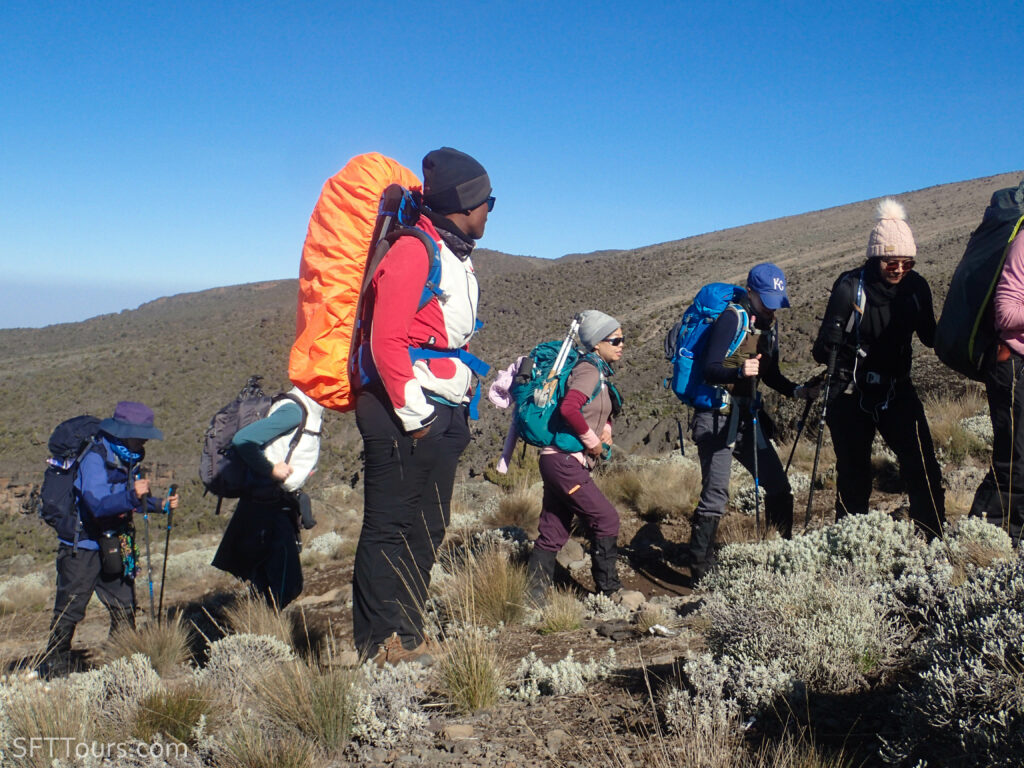
Your porters will trek at faster pace and set up camp before you arrive so you won’t see your gear from morning until you arrive at the next camp each night. This is why you need to have all important items for the day with you in your daypack.
Because your gear bag will be carried by porters, it should be easy and comfortable to carry, and this is why we recommend duffel bags or rucksacks they can carry on their backs. This bag should be 70-90 liters and waterproof, or get a rain cover for it.
On day 2 of our trip, we will focus on the gear you may need and this is when you can repack what you’ll need for Kilimanjaro trek and leave the rest behind or rent anything that you missed.
Note: Porters will take extra care when lifting and bringing down your bag but normal wear and tear is to be expected as the ground is uneven and rocky at several of the camps.
I like The North Face waterproof duffels bags and have one in bright aqua and neon yellow that is easy to spot and can be carried as a backpack to make yours and the porters life easier.
If you’re looking for a backpack that can take you from the trails of Kilimanjaro to backpacking through Europe, the Cotopaxi Allpa 42L is following closely behind the Osprey Fairview 40L as cult classics and trusty sidekicks for all your backpacking adventures. Many of our guests use these two and are super happy with them.
Thule is also a great option of similar quality and specifications and for other more affordable options you can check Elements which is below the $100 price point and from a small business.
Your daypack
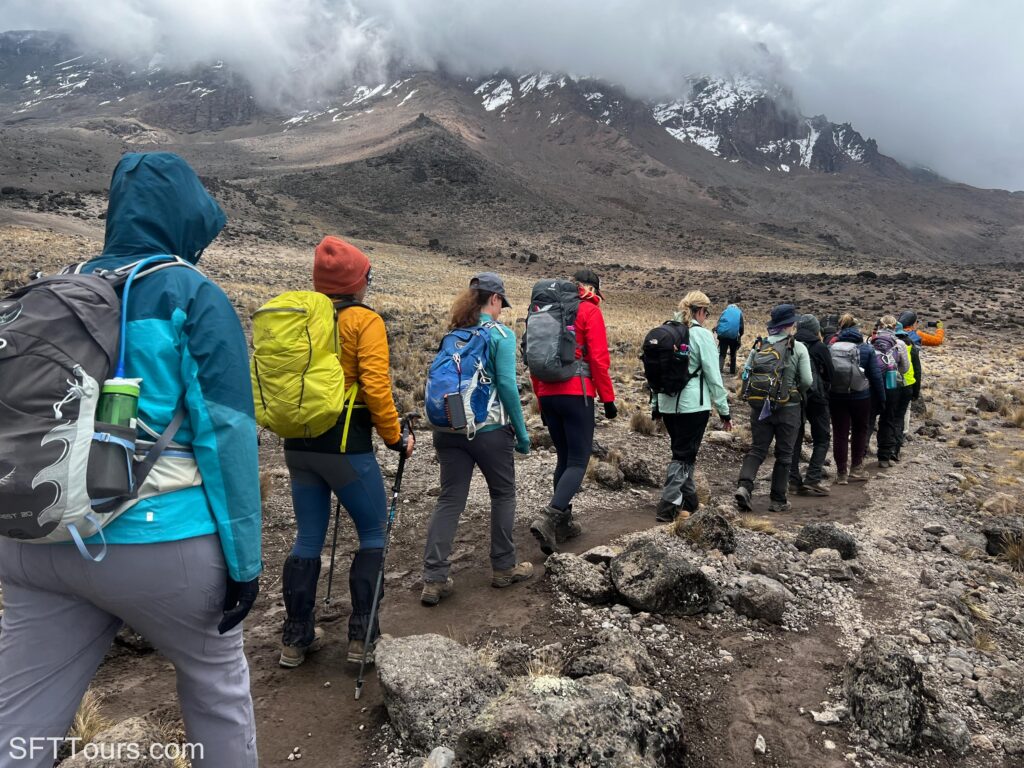
Your daypack should be big enough to carry everything you need each day, usually, that means a 30 liter bag. This should be waterproof or come with a waterproof cover. It should include:
- Your 3l water bottle/bladder
- Your packed lunch
- Toilet paper, or feminine wipes
- Camera / phone + Chargers if necessary
- Hat
- Lip balm
- Sunscreen
- Poncho / rainjacket
- Walking poles if you decide to bring them
- First aid kit
- Snacks
- Tissues and / or wet wipes
The same brands mentioned for the duffel bag also make daypack sizes. We recommend making sure your day pack is light when empty so it doesn’t add to the weight you’ll be carrying, and that it is bright so you can easily recognise it.
What to wear on Kilimanjaro
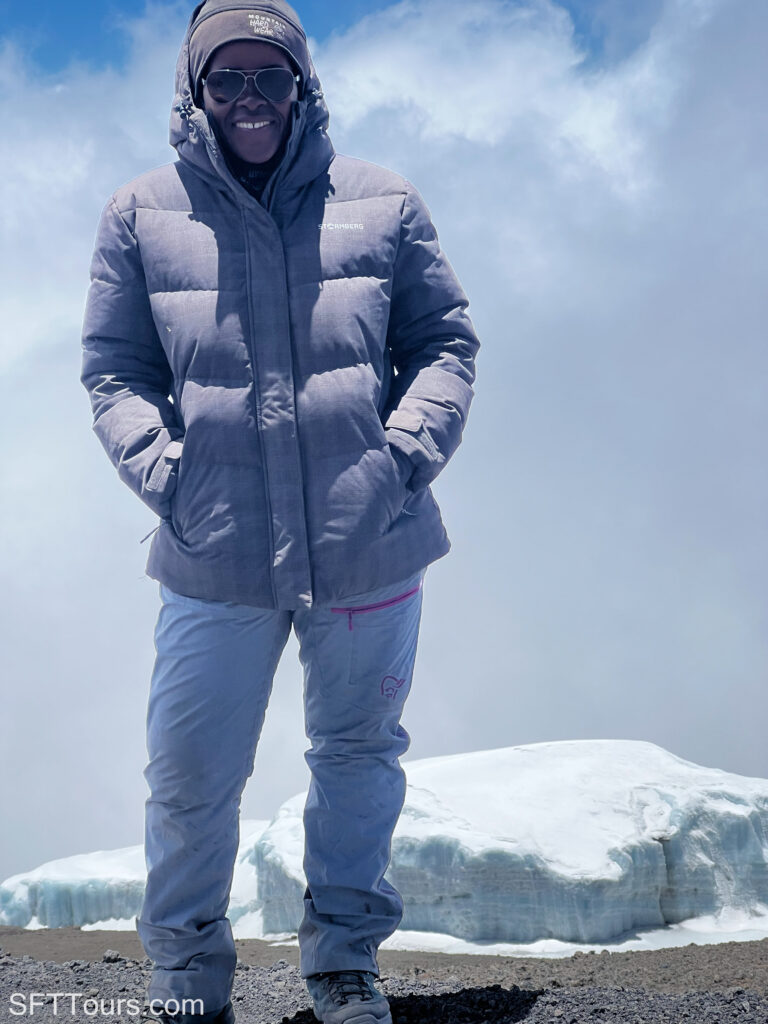
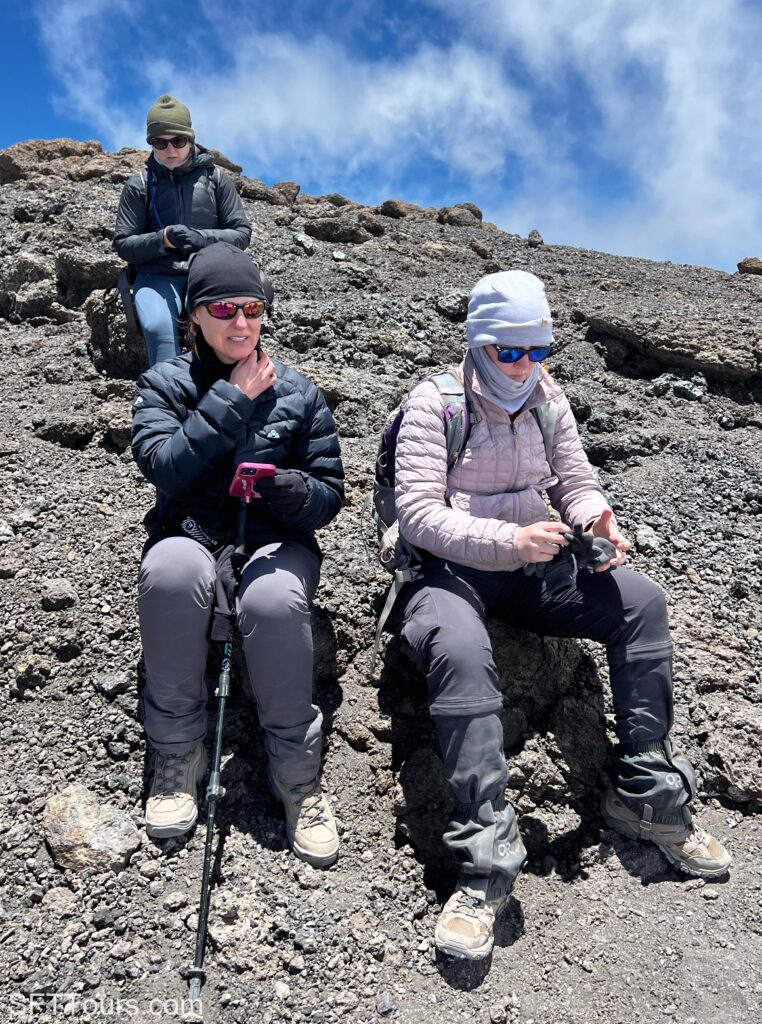
We have divided the clothing section of your Kilimanjaro packing list into your tops, bottoms, footwear and accessories. While we give recommendations on items we have used and wear, there are some high quality brands that are worth checking out.
Arcteryx is a very high quality, durable and premium brand specialising in active outdoor and cold weather which sells truly technical and well thought out gear.
Icebreaker is our go-to merino wool provider and we buy all our base and thermal layers from them. They are more expensive than others but will outlast anyone else by far and look as good as new for months. Pick weights above 200gr for colder temperatures and below that for the lower altitude days.
Tops and jackets
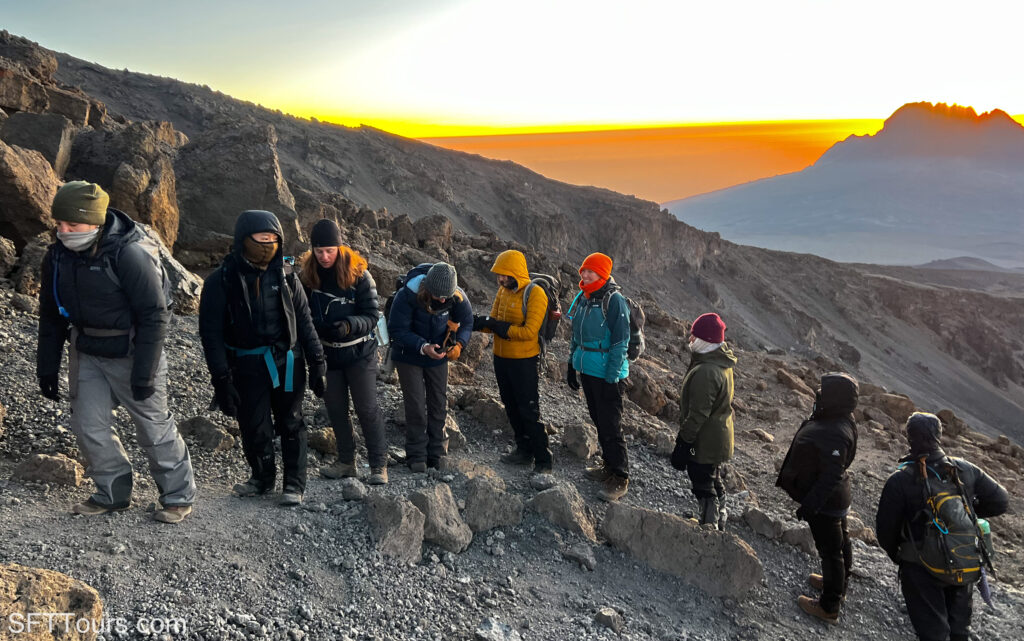
We recommend layering up with 4 pieces of clothing (or even more on summit day): a thermal base layer, a long sleeve shirt or tshirt, an outer layer fleece jumper or sweater and a waterproof / windproof jacket.
You should bring more base layers and fewer outer layers so you can change the base layer in the evenings and wear the same tops layers throughout the trek to minimize gear and weight. You should pack a base layer for every 2 days and 2-3 top layers maximum, to replace in case one gets dirty or wet.
3-4 x thermal base layer tops
Your thermal base layer is the one closest to your skin and should be comfortable and soft. Bring more of these and fewer of the top layers so you always have fresh base layers even if your top layers get dirty. This layer could be a full long sleeve to use as a top layer as well, or a mix of tank/t-shirt styles as well, depending on how cold you get.
We strongly recommend merino wool thermal underwear which keeps dry, regulates body temperature and keeps odor away even if not washed for several days (yes, that’s right!). They are expensive but they work a treat. You’ll be surprised to see how well they keep even after having sweated in them for a couple of days.
2-3 x top layer shirts or long sleeve tshirts
This is a layer you can easily buy from outdoor specialised stores and it should be comfortable and warm.
At lower altitude (days 1-2), you will be trekking in this layer, but it will quickly become a base layer as you ascend and temperature drops. We also love merino wool for this layer and you should get something that is at least 200 gr. Merino.tech has a range of colors and thicknesses that cover all the options.
2 x outer layer fleece or jumper
This is the layer that should keep you warm and it pays to get a properly warm fleece jacket that is designed for cold temperatures.
At lower temperatures, the fleece jacket may be enough. Pockets are useful to put items you may need regularly like wet wipes, lip balm or even snacks.
Pro tip: Pick a jacket that has a collar so that your neck is protected from the sun, wind and cold.
Wind and waterproof jacket
As mentioned, it will get really cold towards the top and on summit day, and you will face strong winds and below freezing temperatures, so packing the right jacket is key.
Your jacket should be wind and waterproof (not just water resistant) and keep you warm at -10 C (14 F).
It pays to check with a specialised outdoor store and look at the temperatures the jacket can withstand to ensure it will be warm enough for your trek.
Ski jackets come in handy in this case. Alternatively, we recommend bringing a compact and packable down jacket that will be able to keep you warm.
Trousers
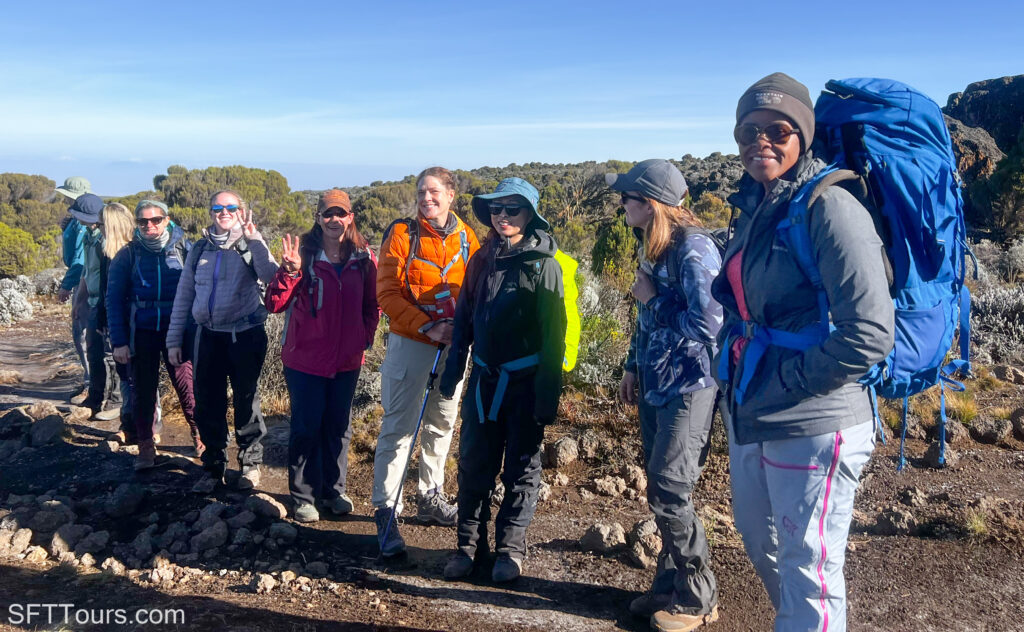
Besides your top layers and jackets, we recommend packing long windproof and waterproof hiking trousers as well as a couple of pairs of lighter and more comfortable bottoms such as tracksuit bottoms or yoga pants for the lower altitudes, the evenings in camp and to sleep in. And don’t forget your thermal merino wool layer that will keep you warm regardless.
Zip-off trousers that can be converted from full length to shorts for the lower altitudes are useful but not necessary. Fleece-lined trousers or ski pants will come in handy for the last days and summit day, or you can layer your thermal underwear and leggings below your hiking trousers, just bear in mind when you buy the size so there is space underneath to add a layer.
If you don’t want to buy new wind and waterproof trousers and already have several regular hiking trousers, you can also bring one water / windproof shell layer to carry in your daypack and put on top in case of rain.
Footwear
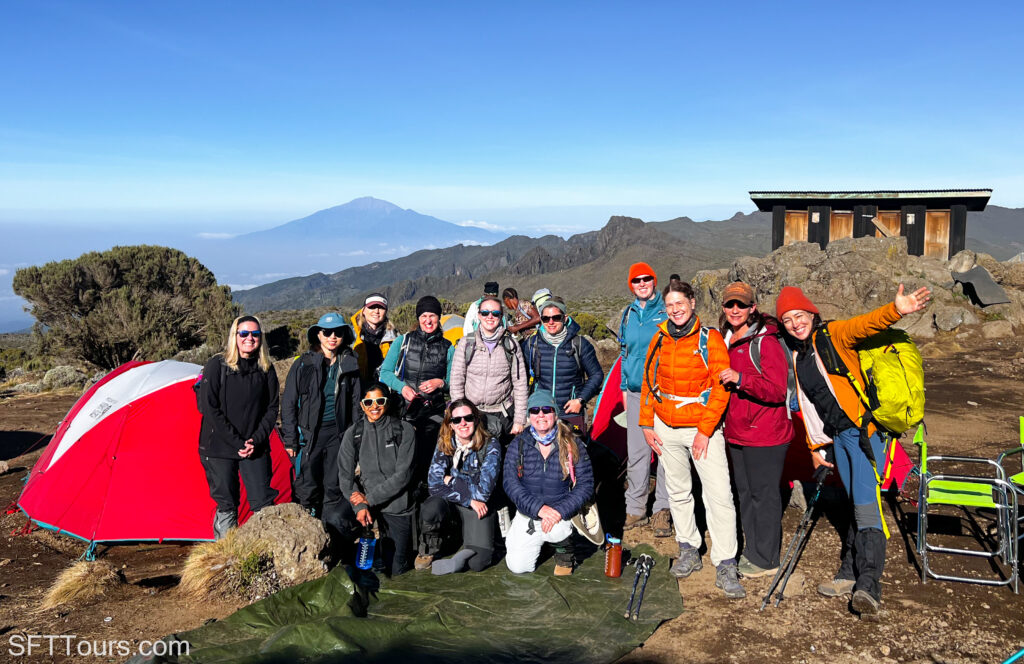
Waterproof hiking boots are critical to the success of your climb and we strongly recommend you break yours in by training in them for long periods of time before the trek so you can be sure that they won’t cause you blisters. If you are buying new boots, make sure you can wear them with thick hiking socks.
We favor Gore-tex boots because they are high quality and ensure your feet will stay dry even in the rain and snow.
Having wet feet can significantly impact your ability to stay warm so your boots are arguably the most important item. They are also a piece of gear you can’t easily borrow from others on the mountain should the need arise.
These boots are an Amazon favorite that are waterproof with ankle support, and a grippy rubber sole. Your boots should also offer ankle protection so you don’t twist it while hiking on rocks and stones. Don’t forget to pack thick and long warm, merino wool socks to make sure your feet can regulate temperature.
In addition, you should also pack a pair of light closed-toe shoes to wear at the camp. These should be easy to put on, in case you need a middle of the night bathroom break.
Crocs are pretty popular on Kili because they are easy to slip into and wide enough to let your feet expand, but any comfy pair will do.
Accessories
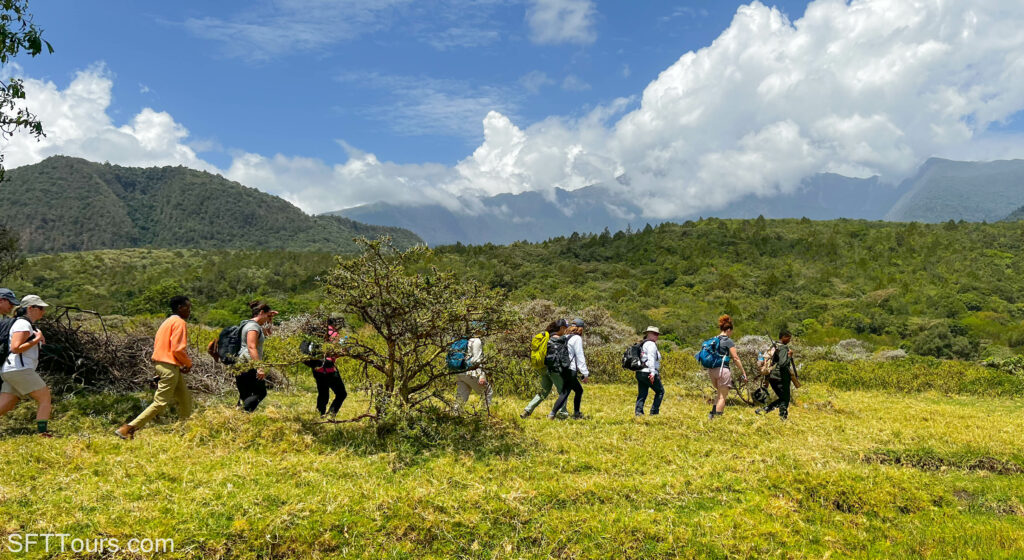
Besides clothing, there are a few handy accessories that we recommend bringing.
- Scarf: A warm scarf, neck warmer and / or a balaclava will work to keep all your face including nose and cheeks, warm when needed.
- Hats: You will need two, one to keep your neck and face off the sunlight and one to keep it warm. A cap may be enough but a wide brim hat like the ones you wear on safari might be better as it provides more coverage. Keep your head warm with a proper wool or fleece beanie hat that will not only trap warmth but also keep your ears warm, and your messy hair tucked away for photos! I, of course, like Icebreakers’ merino wool beanie hats, but I am also partial to the nice knit beanies, especially the fleece or fur-lined ones.
- Gloves: Extra warm waterproof gloves or those which come in layers so you can use the thinner ones on warmer days and add more layers towards the top. Ski gloves work.
- High hiking socks: Socks are important to keep warm and make sure your feet don’t get blisters. You may want to pack a pair for every day. On lower altitude days you are fine with thinner socks but bring thicker for the colder days.
- Hair ties and / or bandana and / or hair band: I have very thin long hair so a wide hair band helps me keep my hair in check in the wind and dust of an open top vehicle and it can even be an alternative to a hat if you are ok with wearing sunscreen. Any type of bandana will also work to keep hair tucked away with the help of some hair ties or scrunchies.
- A poncho or rain jacket: A poncho or waterproof rain jacket will be useful in the lower altitudes where rain is more common than snow and it’s too hot to wear your waterproof jacket. Make sure it packs light and please do not bring single use plastic ponchos, those are not allowed on the mountain and are terrible for the environment.
Hiking gear
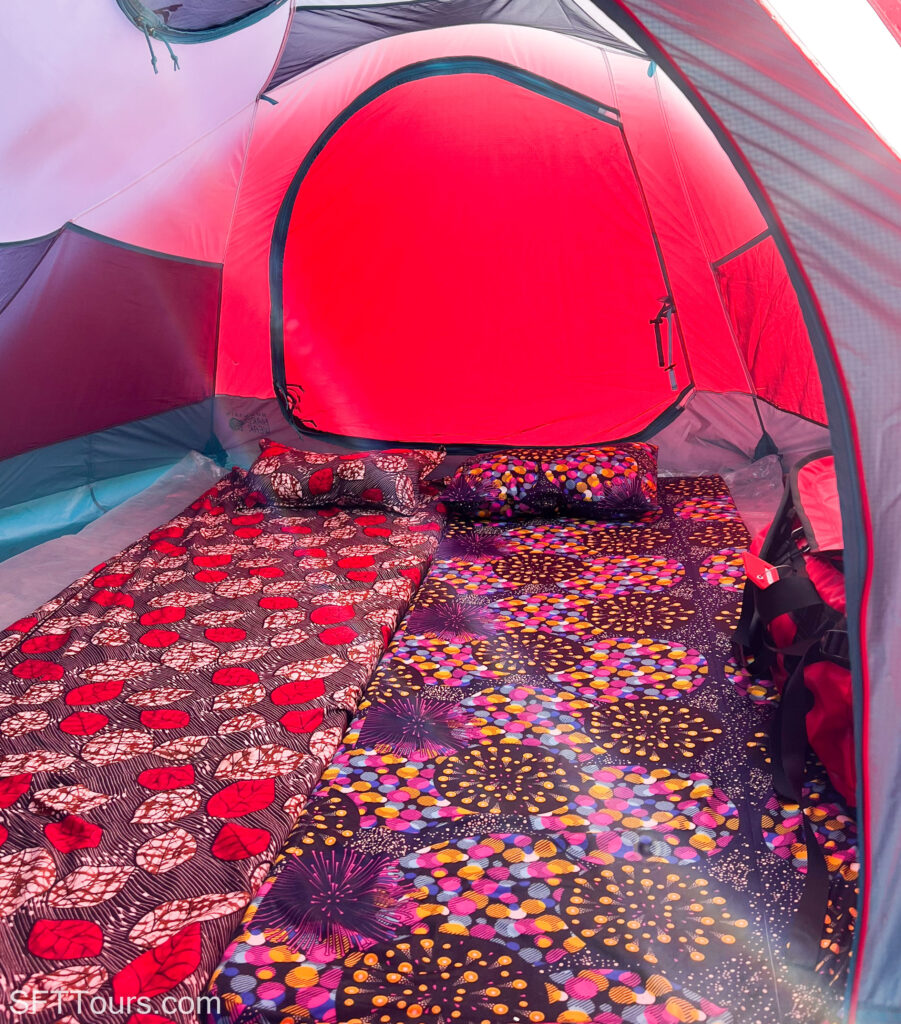
Because we will be camping every evening, there is hiking gear you’ll have to bring with you. On our trips we provide the main equipment, but there are a few items you’ll have to bring or rent locally.
- Sleeping bag and liner: Because of the change in temperatures between bottom and top, we recommend packing a 4 season sleeping bag. A fleece liner is also useful and will keep you extra warm as you ascend.
- A pillow case or blow up pillow: This compact blow up pillow is useful if you are used to sleeping with a pillow. If you bring just the case you can fill it up with your own clothes.
- A towel: You’ll need a small quick dry towel to wash your face at camp. You don’t need a large one for this as you will only use it for face and hands.
- Torch: A headlamp is useful around camp but any small flashlight will do. Make sure it has enough batteries.
- Walking poles: Some people swear by them, especially for coming down, others find them annoying. You should test your hiking poles out on hikes around where you live before packing them.
- 3 liter water bottle: You will need to drink a lot of water on the mountain, more so if you take altitude sickness medication (eg. Diamox). Bring your own water bottle or bladder to be replenished daily at camp.
- Hand warmers: If you are prone to feeling cold, we recommend packing hand and feet warmers. They are easy to pack, light and will give you a burst of heat, which you will find particularly useful on summit day. Check these out.
- Gaiters: These handy little pieces of gear will go over your ankles and keep pebbles and mud or water from entering your boots.
Other items you should pack for Kilimanjaro
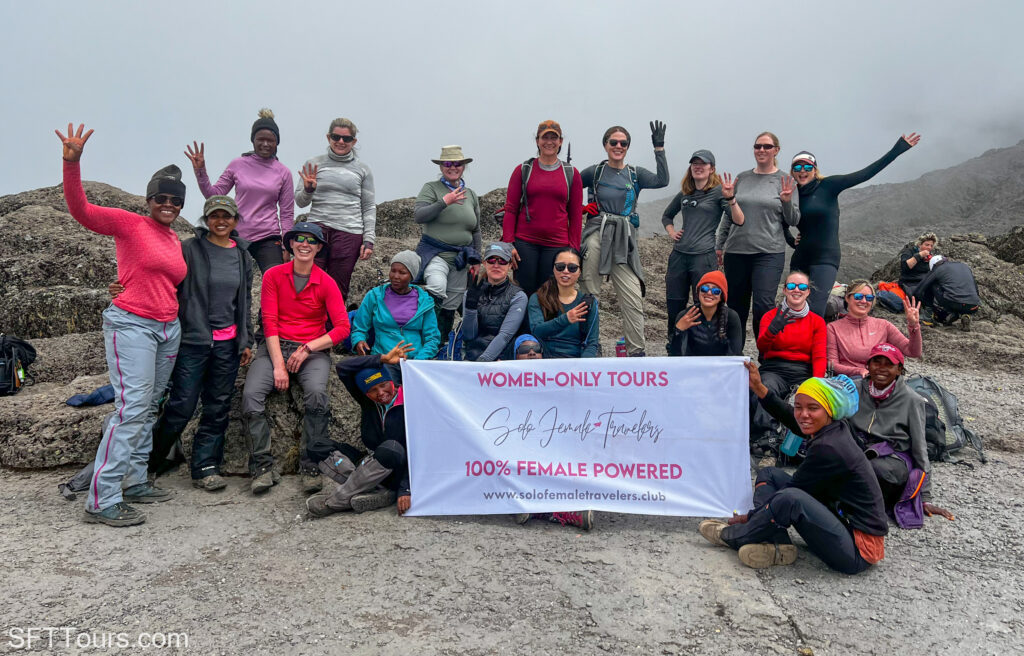
Besides packing the right clothes, there are a few others items you should include in your Kilimanjaro packing list, below we list a few handy ones:
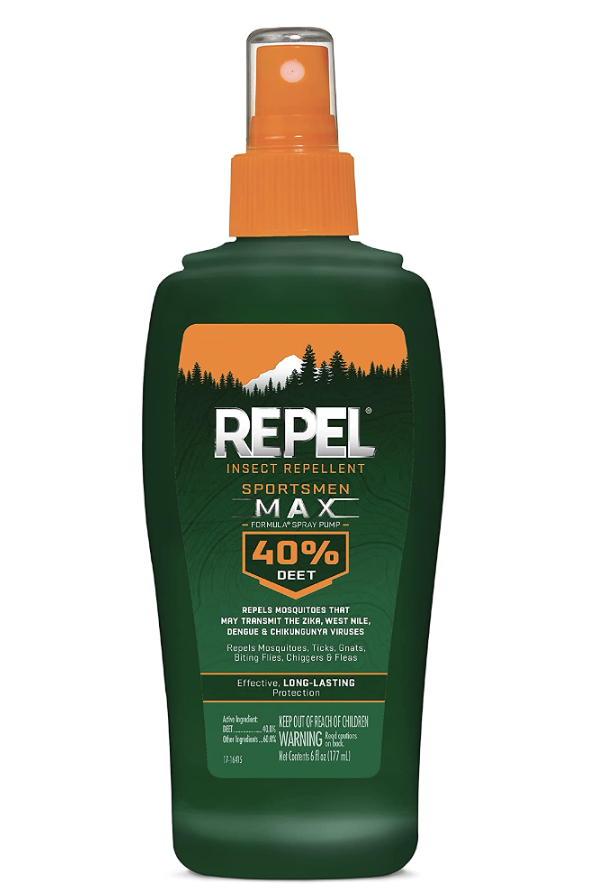 | Repellent: This will be useful in Arusha and if you are going on safari after the trip more than on the mountain as mosquitoes do not live at higher altitute. While I strongly recommend you take Malaria tablets as a precaution (and you should get the proper medical advice on this) and get the necessary vaccinations (Yellow Fever, Typhoid Fever, etc.), the best way to protect yourself from nasty bites is by spraying repellent. Everyone has their favorites, from the natural repellents that use citronella and other ingredient to the DEET-based repellents. When I worked across East Africa for 5 years and was not able to take Malaria tablets on a daily basis, I always wore long sleeves, long trousers and high socks, then generously sprayed repellent with a high DEET concentration (minimum 30%). I find that, unfortunately, natural repellents just don’t work in the bush and DEET is essential. However, everyone is different and what works for someone may not work for someone else. If you decide to use DEET-based repellent, beware that it is a toxic chemical and you should apply it in an airy place and wash your hands thoroughly to avoid having an upset stomach (from then touching your mouth). If you buy repellents with a high concentration of DEET (eg. over 50%) beware that their chemicals may melt plastic, including the bag which you may store them in or your sneakers (yep, true story)! I prefer to spray repellent on my clothes instead of on my skin. In the lodges, mosquito nets are often placed over the beds at night and tented camps have mesh windows. I have relied on the brands Repel and OFF at home in Singapore and in the bush and tropical jungles for years, they just work. |
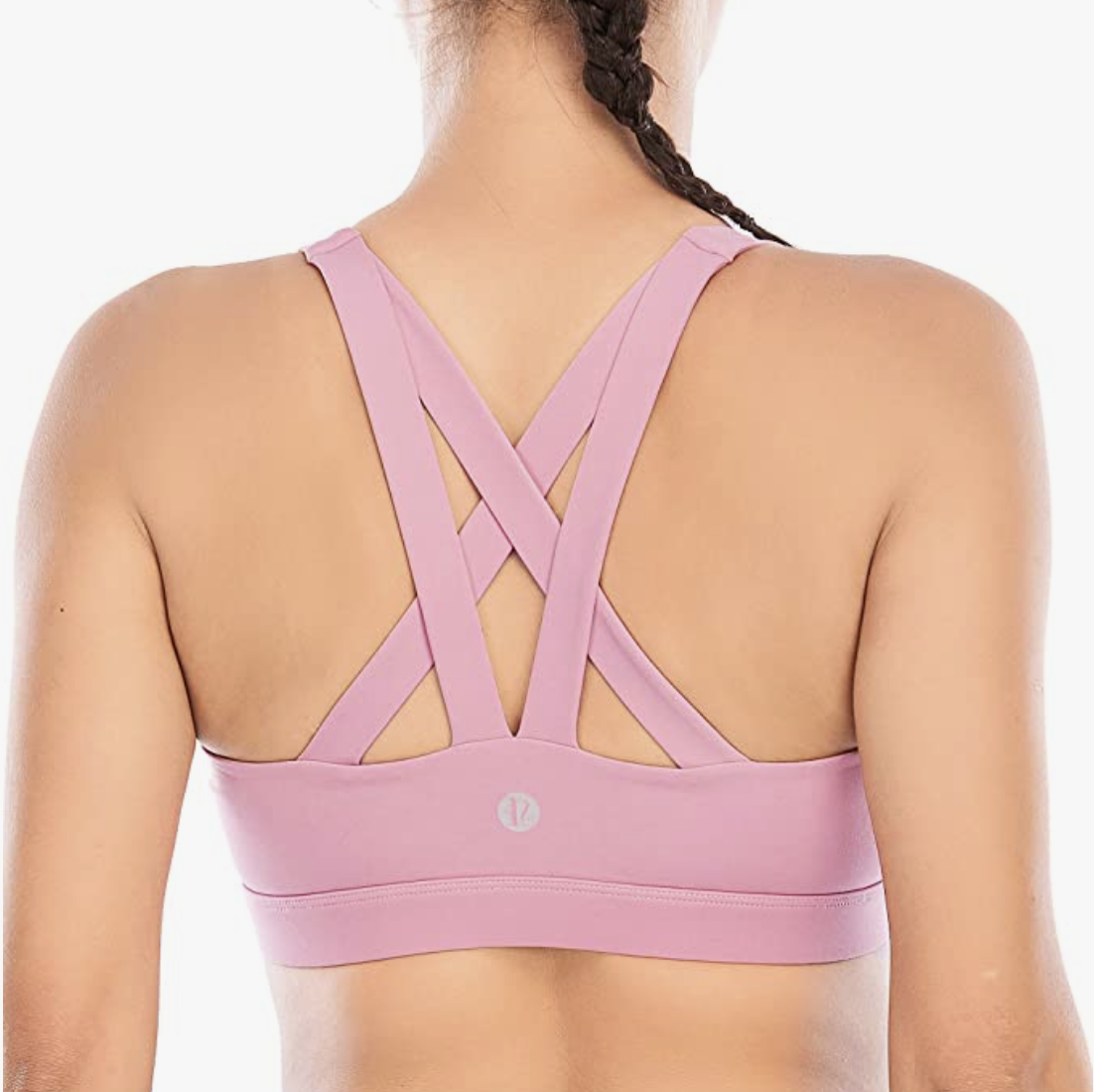 | Sports bras: More practical and comfortable than wired bras, we recommend you bring sports bras, especially those designed for running like these ones. |
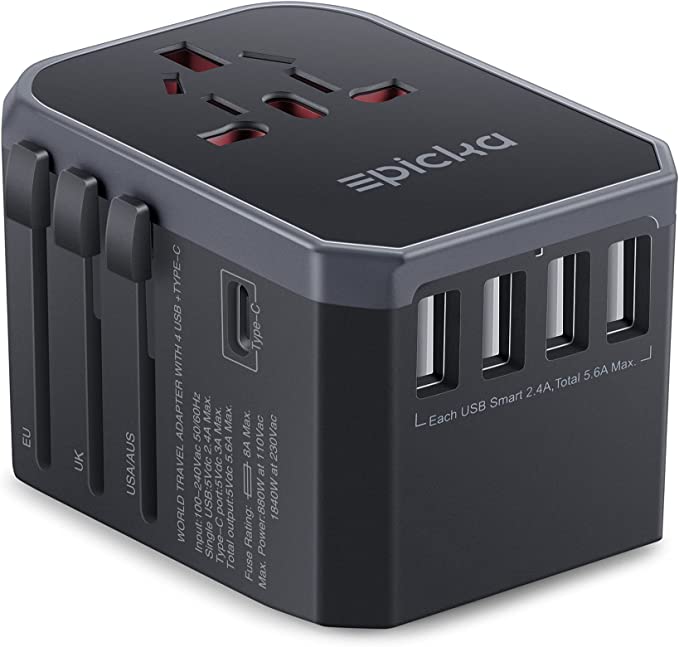 | Universal plug adaptor: Tanzania uses standard three flat prong UK plugs. I like the ones which come with USB ports so that we can charge phones, cameras and everything else with just one adaptor. I love this one because it has USB ports for all the electronics we now carry. |
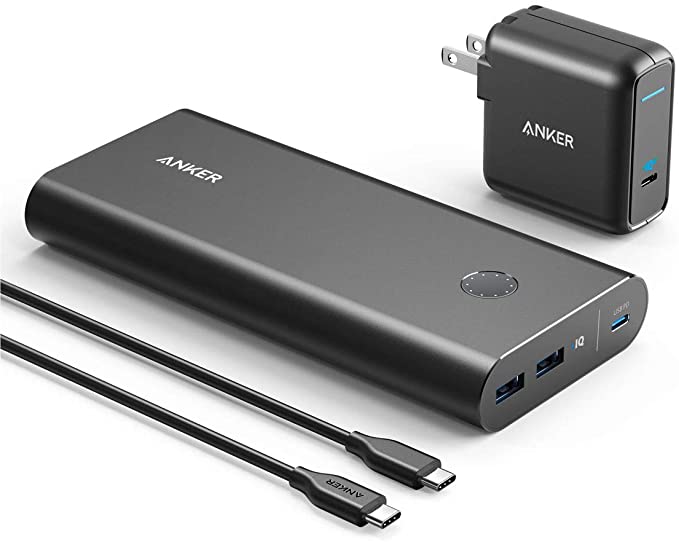 | Power bank: You will be on a mountain with no access to electricity so bringing a portable battery is essential if you want to charge your camera or phone to take photos. This Anker Portable Charger has a 26800mAh capacity, and fast-charging USB-C ports, you can power up your devices in a flash, while the LED display keeps you in the know about your battery level. This one is big enough to charge your phone several times. For a solar-powered one, look at this one. Tip: sleep with your power bank inside your sleeping bag to make sure it doesn’t freeze or stops working when it gets cold outside. |
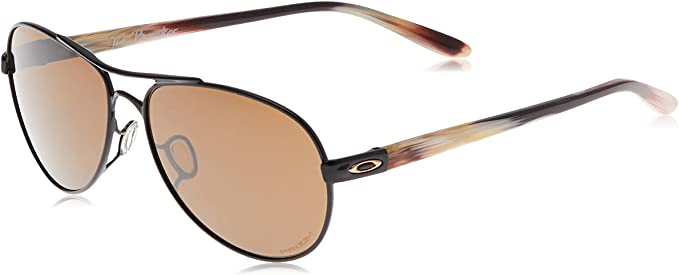 | Sunglasses: It is imperative to bring sunglasses as the sun is really strong at higher altitudes and the sun rays will reflect on the snow. I like the wrap-around sports Oakley sunglasses as they are polarised and protect your eyes from any damaging sun rays and from the dust. I have used several versions of this pair for the last few years (they scratch and I get a new pair). Make sure to pack a cloth to wipe and clean your glasses from dust. |
 | Sunscreen: One of the most important items in this packing list is sunscreen. The sun is very strong on the Equator and you will be under its powerful rays for many hours, protecting your skin is key. This one is a best selling one, is moisturising and has a mineral barrier, which you need at high altitudes. |
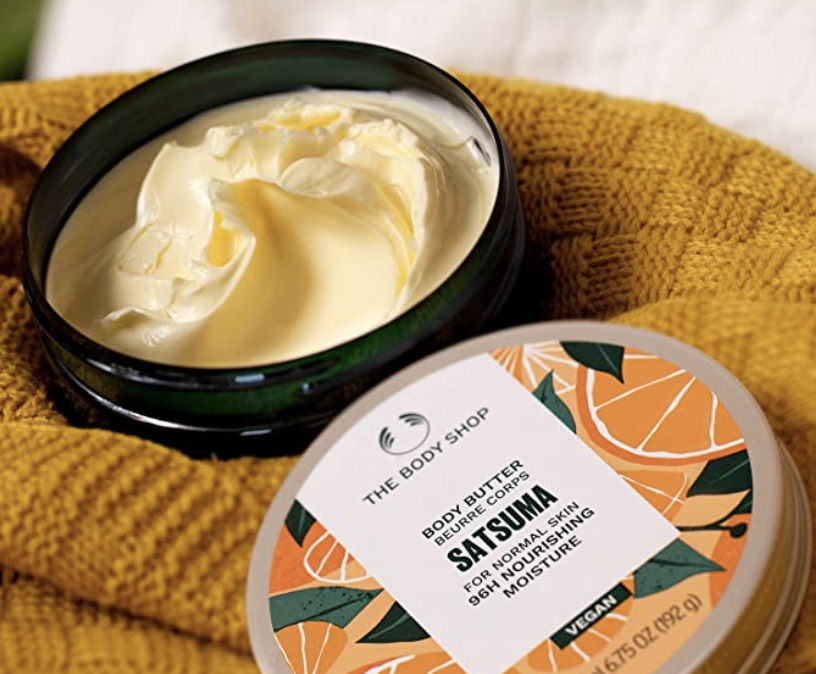 | Body lotion: The harsh weather can be quite hard on the skin. Plus it’s more environmentally friendly to bring your own in a small reusable bottle than to use the disposable toiletries given at hotels. Everyone has their favorites but you really do need hardcore hydration in the dry bush. Ideally the same can be used for hands and body. My sister gifted me a Body Shop Christmas Advent calendar that came with many of their products to try and this 96h hydration body butter is amazing. It comes in a flat recycled plastic tub with an aluminum lid that’s super easy for travel and anti-spill (I can testify to that since I’ve traveled a few countries with it). |
 | Biodegradable tissue and wet wipes: There are no showers on the mountain so you should bring a couple of packets of biodegradable wet towels handy to wash face and hands from sweat and dust. These ones are specifically designed for outdoorsy people and for getting rid of dust and sweat, and you may want to consider packing intimate wipes as well. Pack at least 2 of each per day. Meg was quite disappointed to find out that the tan she thought she had picked up was actually dirt when using a wet wipe! |
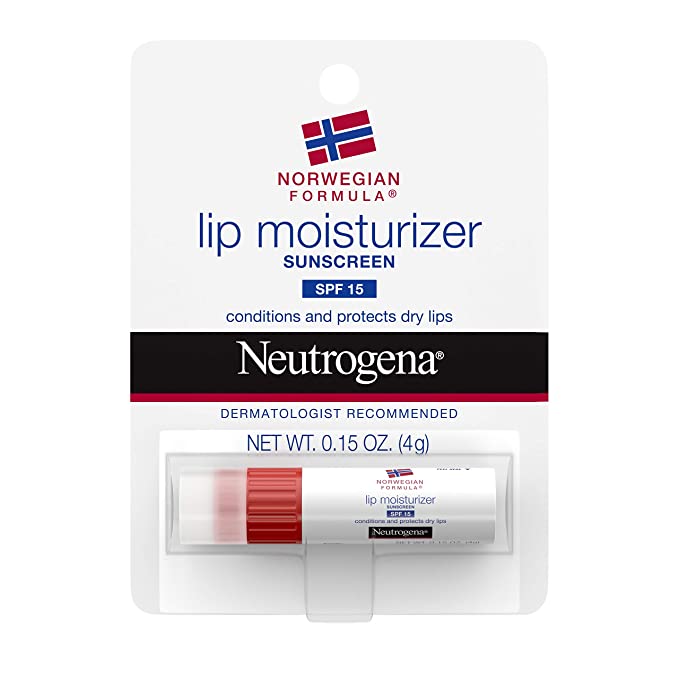 | Lip balm: The sun makes it particularly tough for the skin and lips so you should bring a lip balm to stay moisturized. We find these are essential to not end up with completely ruined lips or even blisters. This Neutrogena one is specifically designed for cold, harsh weather, and has SPF 15. |
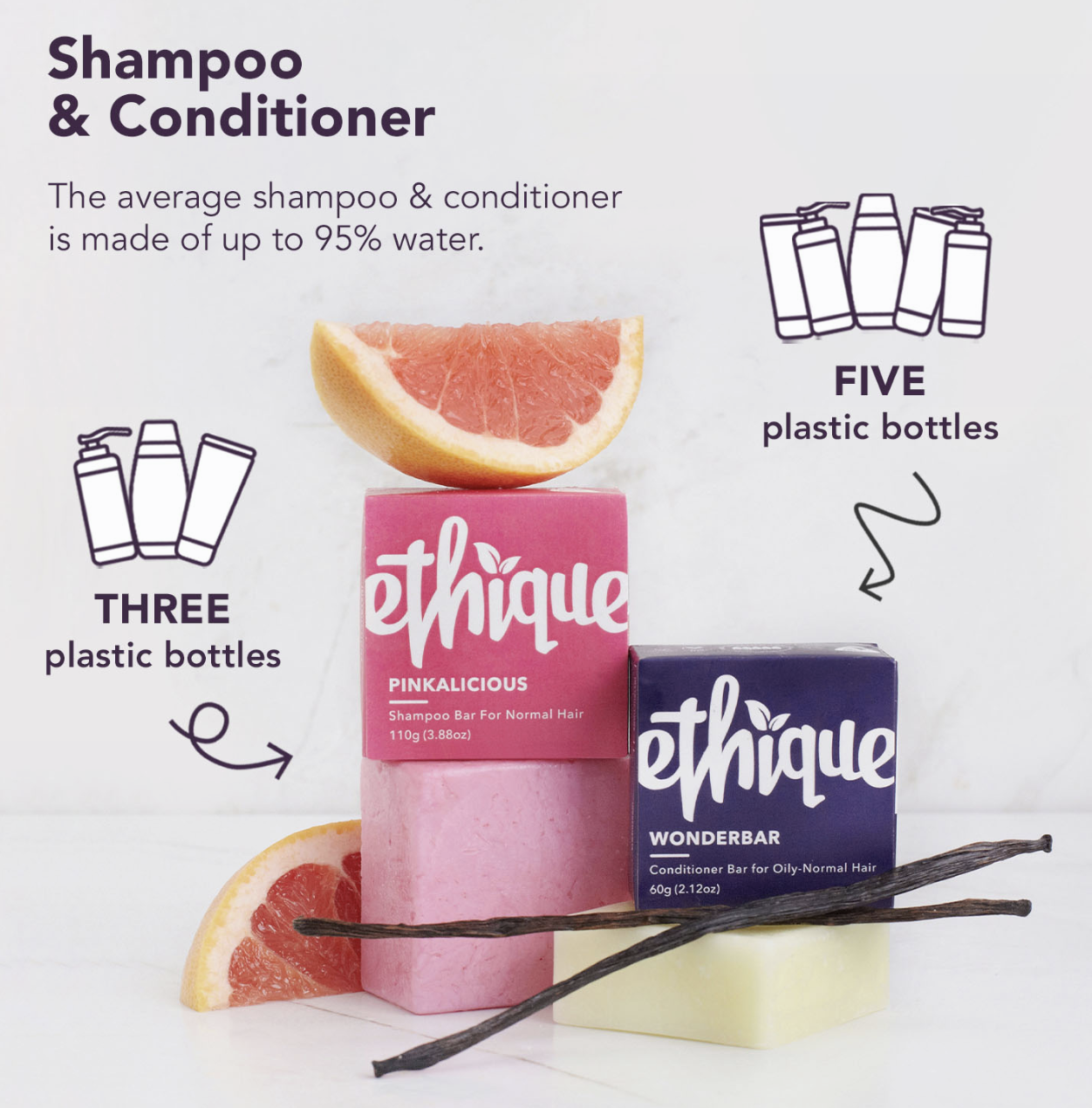 | Environmentally friendly toiletries: While there are no showers on Kilimanjaro, you will get the chance to wash your hands and face with water at camp and brush your teeth. Bring environmentally friendly, chemically-free products such as soap bars and help us preserve the beautiful park. Bonus: Environmentally friendly products are also lighter and pack better (lower chance of spills). Add toothbrush, hair brush, stick or dry deodorant (liquid may freeze and sprays will explode), moisuriser, tampons / sanitary pad / menstrual cups and a sanitary bag to take the used ones away from the mountain. I particularly like the brand Ethique. They also sell samplers so you can try a few of their products and see if it is for you. Consider other sustainable products such as toothpaste bits or reusable cotton buds to minimize the wastage you leave behind. PS: Bring a ziplock bag to store the bars after use since you may not have time to wait for them to dry before having to pack and check out. |
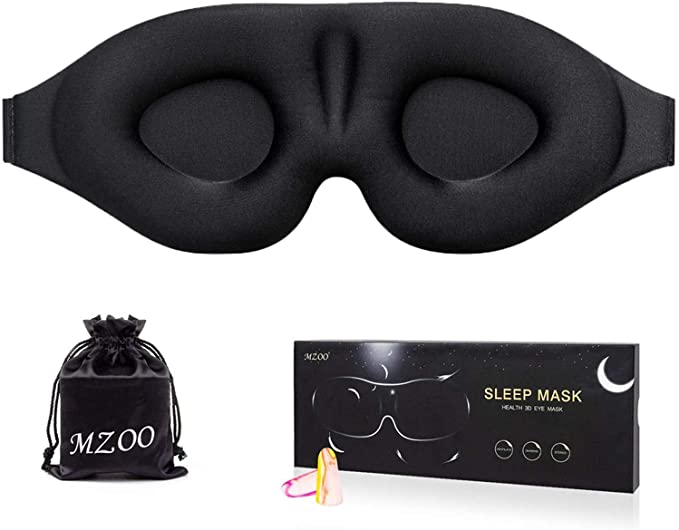 | Sleep mask: Although hotels have proper blinds, you will be sharing the room with another traveler who may be a late owl. Bring a sleep mask like this one to block the light. Or upgrade to Manta Sleep, I have been using the sound mask for months now and it is INCREDIBLE both for the flight as well as to sleep at night and get over the jetlag. It is magic when paired with my Calm app. |
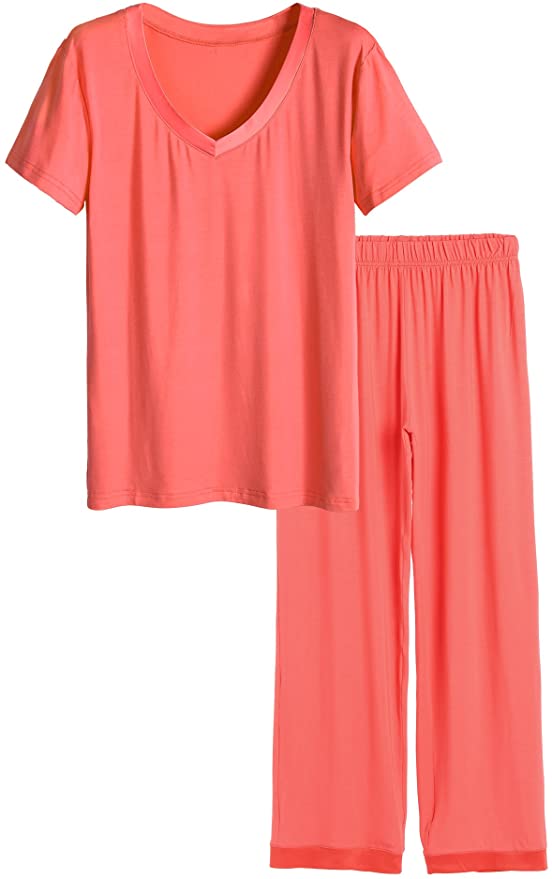 | Pajamas: As mentioned, you will most likely be sharing a room so don’t forget to pack your pajamas! Here’s a comfy choice from Amazon. |
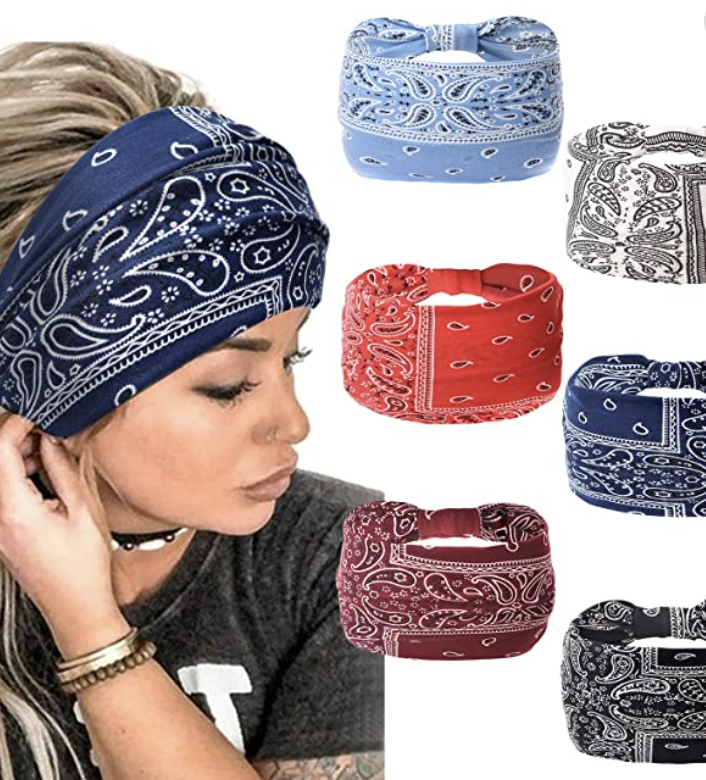 | Hair ties and / or bandana and / or hair band: I have very thin long hair so a wide hair band helps me keep the hair in check in the wind and dust of an open top vehicle and it can even be an alternative to a hat if you are ok with wearing sunscreen. These ones are versatile. |
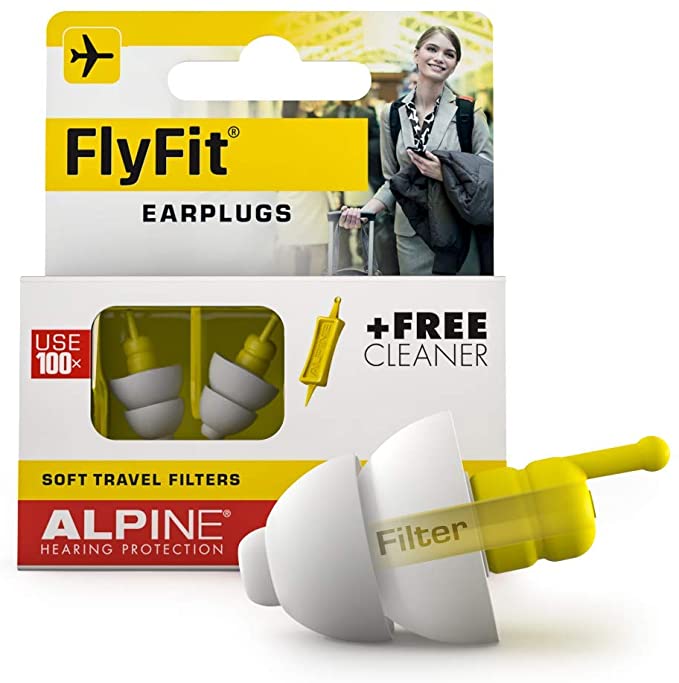 | Ear plugs: If you are a light sleeper, a pair of ear plugs can help you sleep better and block out the sounds of the bush. We will be sleeping in lodges with thin canvas walls and surrounded by wildlife. Many animals are nocturnal and it is not unusual to hear their call at night. Check out these from Amazon. |
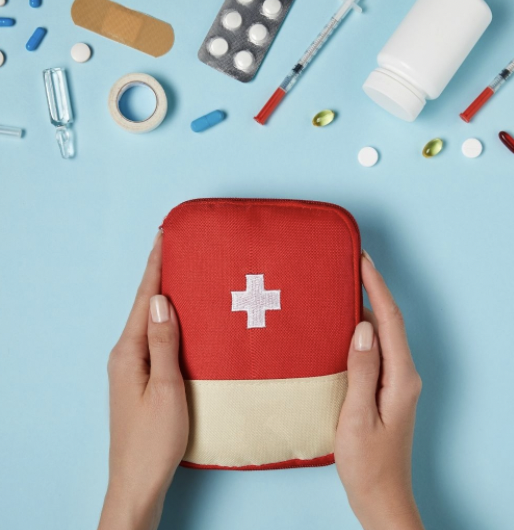 | First aid kit and medication: Available medications, brands and products in Tanzania may not be the same back home so it’s always best to bring everything you are used to and of course, all prescription medication or vitamins you take. I also recommend packing a basic first aid kit with items such as painkillers, plasters and antiseptic ointment, motion sickness tablets, antihistamines, electrolyte powder in case of diarreah plus any other tummy ache related tablets or medicines your doctor may suggest (antacid, diarreah tablets, Diamox, etc.). Travelers diarreah is the most common ailment when traveling especially in countries very different from your own. See our First Aid Kit list here. |
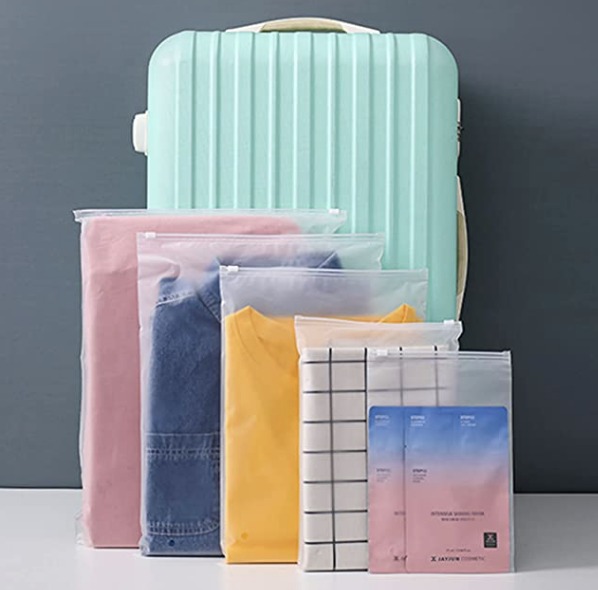 | Large ziplock bags: These will be useful to put dirty clothes, shoes, etc. Remember plastic bags are not allowed into Tanzania and only reusable ziplock bags are. |
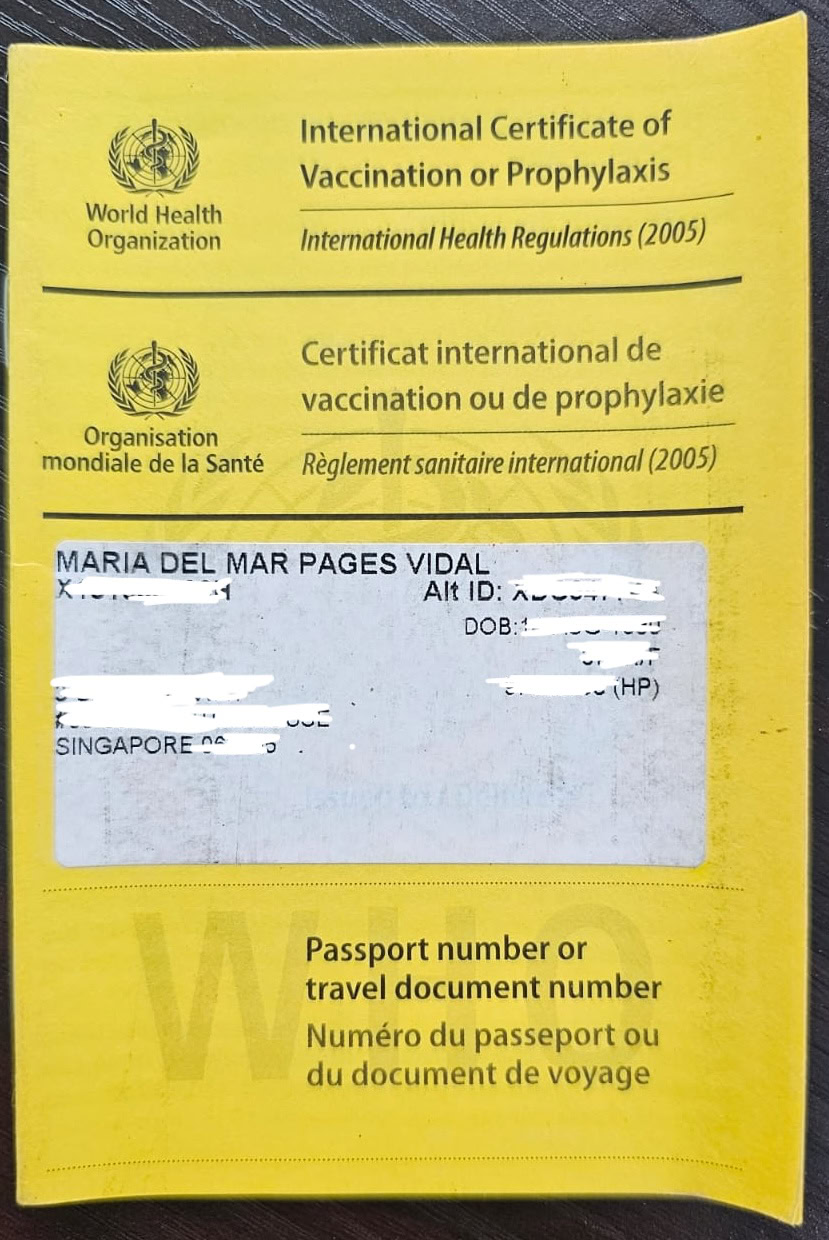 | Vaccination certificates: If you are coming from an endemic Yellow Fever area or transition through one for more than 12h, you should make sure you have taken your Yellow Fever shot. This includes coming in from Ethiopia or Kenya or transiting through either for more than 12h. |
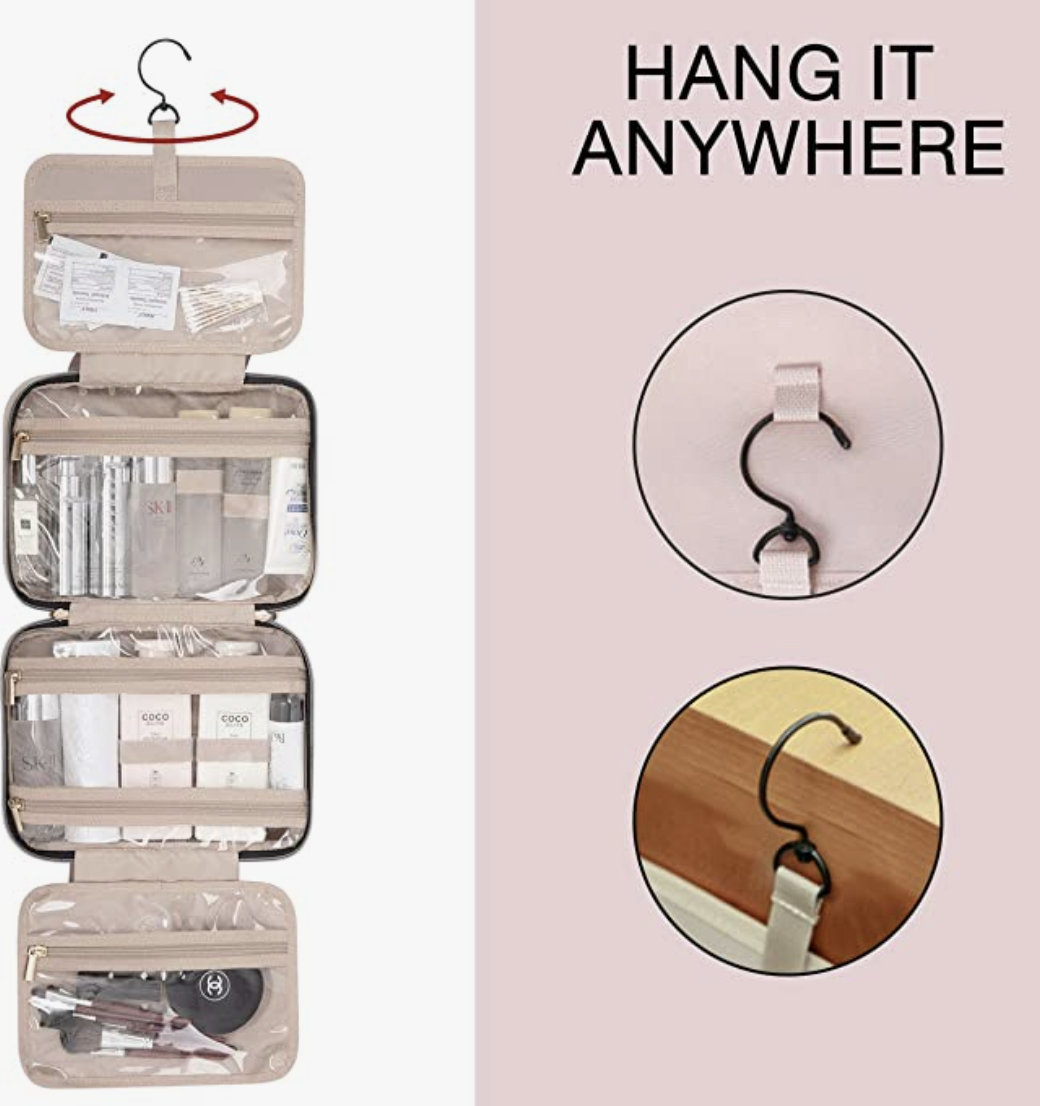 | A foldable toiletry bag: I always travel with a foldable toiletry bag which I can hang anywhere. They also help you keep everything easy to find and tidy. This one is very cute. |
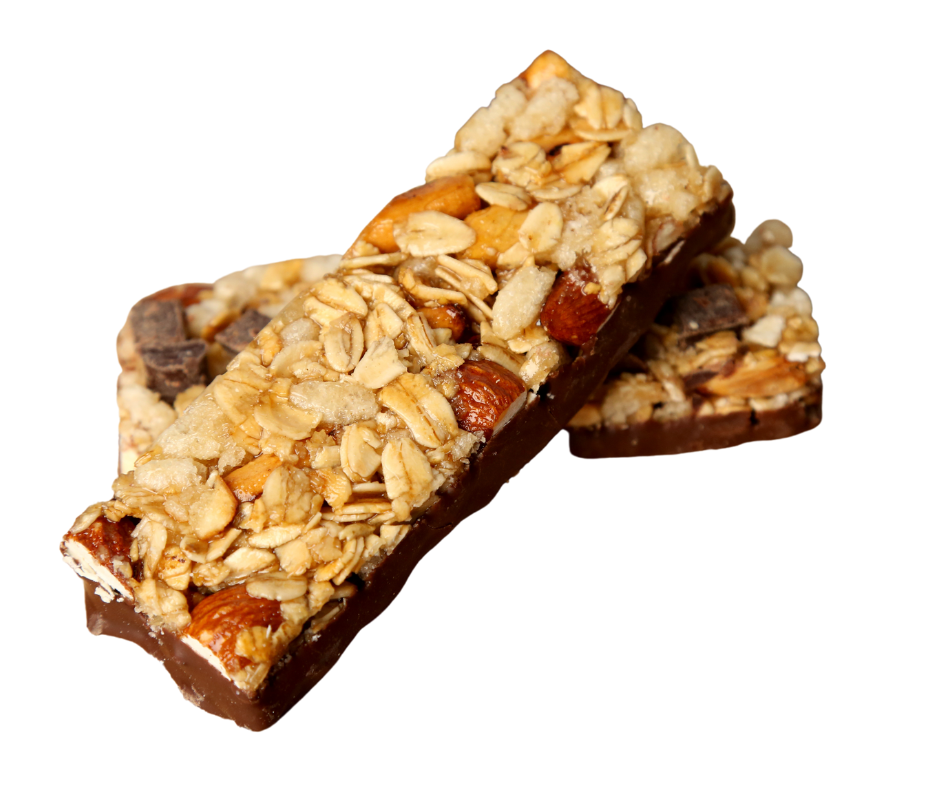 | Your favorite snack and electrolyte powder: All food will be provided, including snacks, but if there are specific comfort foods, energy bars or sweets that you like, feel free to bring them, just consider the weight limitations and pack away your wrappers. For electrolytes, bring one of the tablets that are easily packed in a tube, I always take these ones from Nuun when traveling somewhere where the weather is hot or dry. |
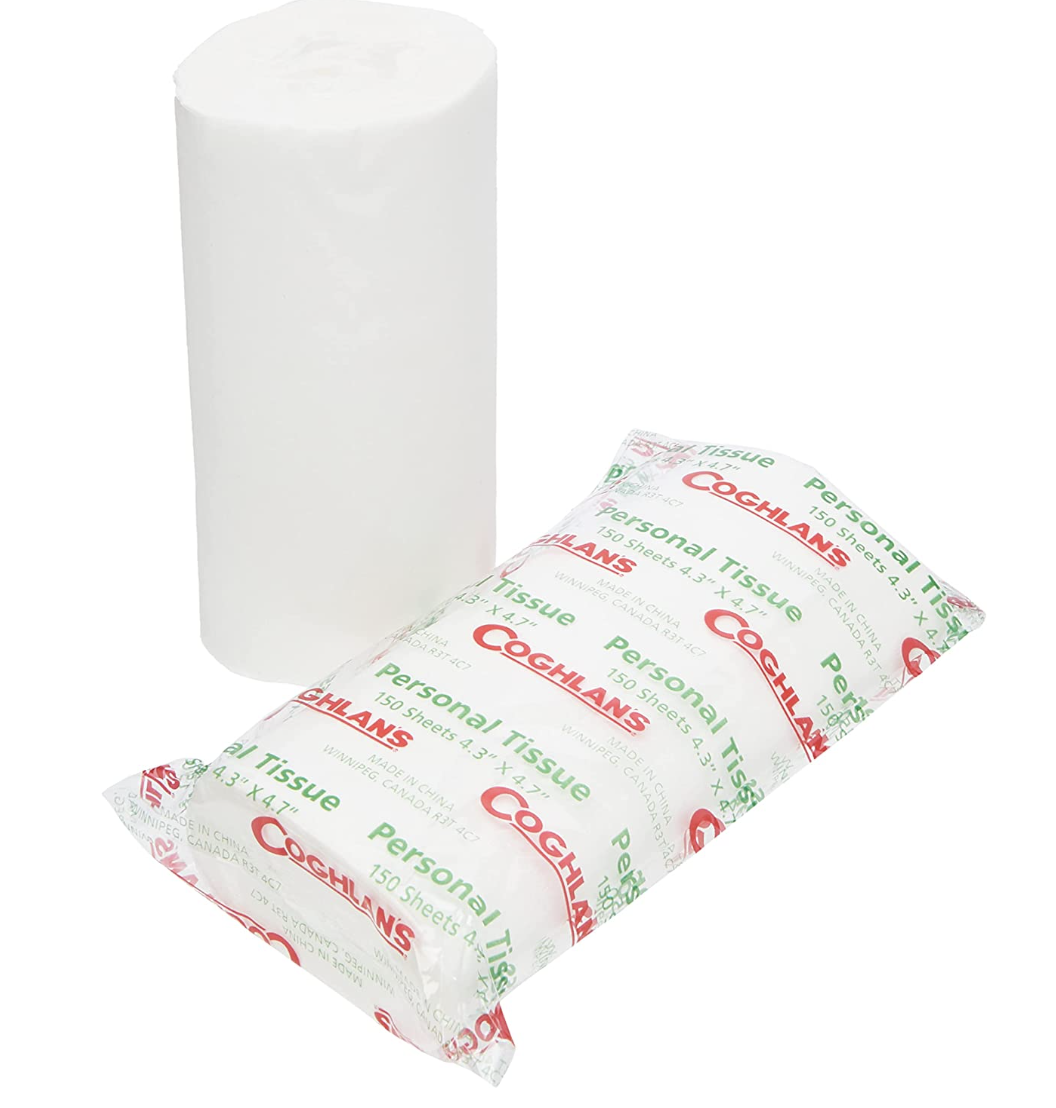 | Toilet paper roll: You’ll have to make use of wild loos during the climb (camps will have flush toilets) so bring your own 2 or 3-ply – trust me, it will be very welcome. You may wish to bring spare in case other climbers catch on and ask to use some from you! This portable camping toilet paper is convenient. |
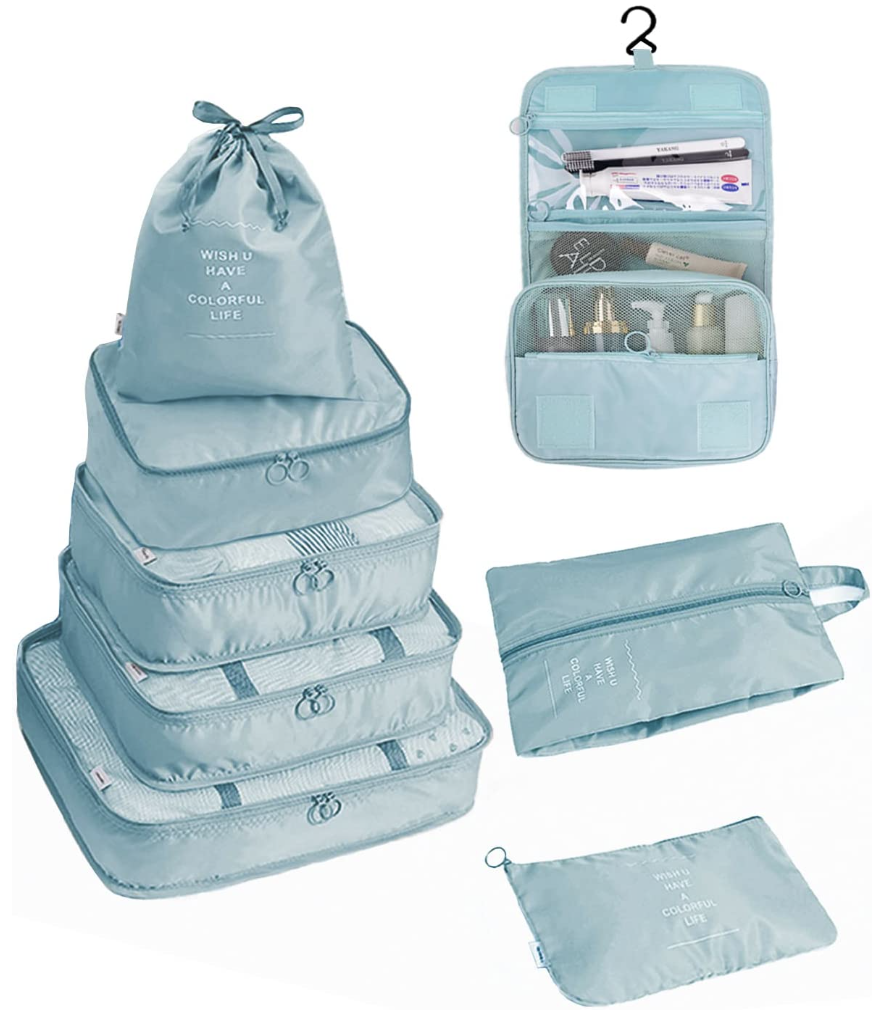 | Packing cubes: Not essential but very useful to keep everything organized and within easy access inside your duffel bag, so you can easily repack from your main bag into your daypack each morning. This set comes with a foldable hanging toiletry bag too. |
Things you should NOT bring on your Kilimanjaro trek
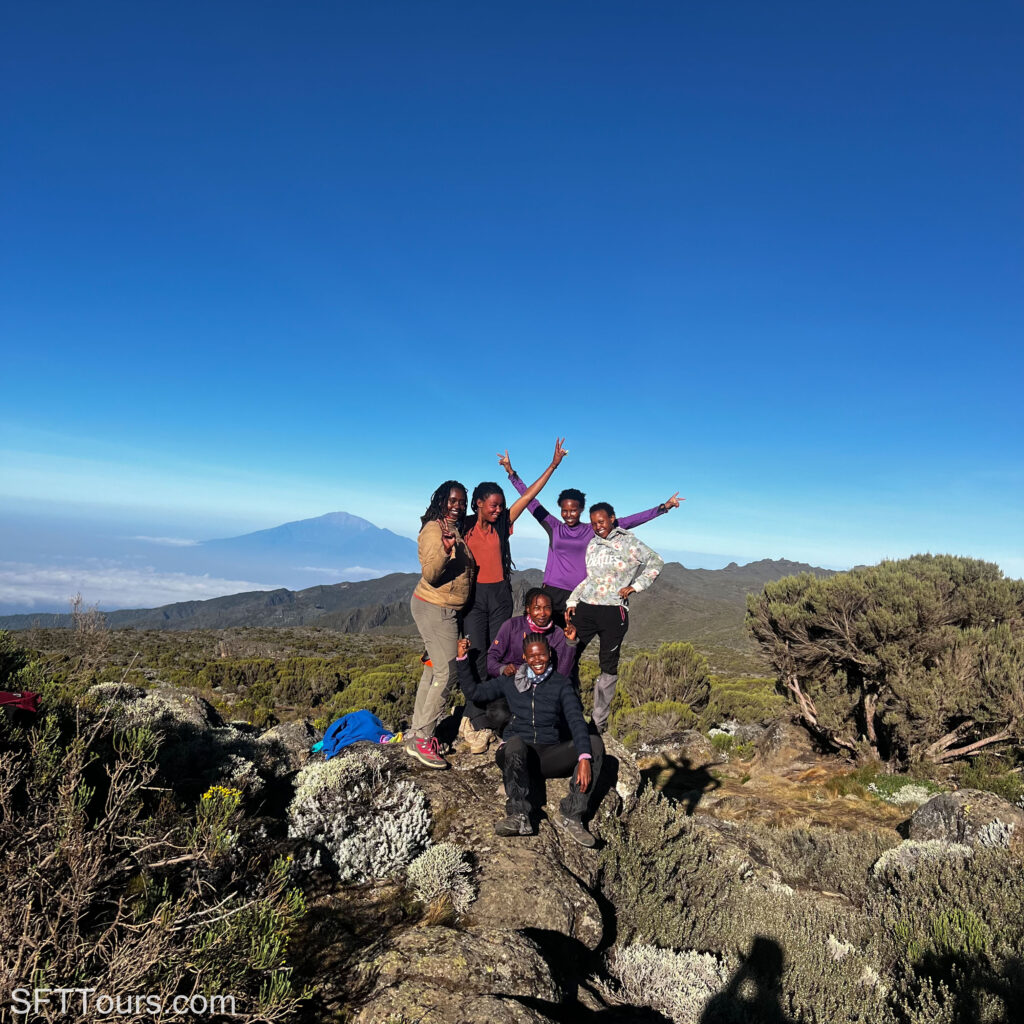
There are several items that may occupy a lot of space in your luggage and which you will find no use for on Kilimanjaro, so we recommend leaving them behind in Arusha.
- Hair dryer: Needless to say, you won’t be showering for a few days and there is no electricity to use a hair dryer.
- Speakers to play music: Loud music will not be welcome on the mountain. Instead, bring headsets if music helps you get energized and in the mood. We prefer to listen to the mountain sounds but this is a matter of choice. Music and motivational lyrics may help you stay distracted and focused on reaching the top on the final summit day, but don’t force your style of music on others.
- Laptops: You will not find an opportunity to charge or use a laptop so it is best to leave it behind in Arusha.
- Tripods: If you are an avid photographer and plan to photograph the starry night or the Milky Way (which by the way can be incredible) you may think to pack a tripod but the reality is that you’ll be exhausted and the last thing you’ll think about is taking “that” shot. If you insist, bring a really light one.
- Make up: You will not find use for it on the mountain, and trust us, no-one will be wearing it. You’ll likely be judged more for wearing make-up, than for not.
- Universal plug adaptor: As mentioned, there are no sockets to plug anything in. You can leave them in Arusha.
- Spray bottles that are pressurised and will explode at high altitudes.

